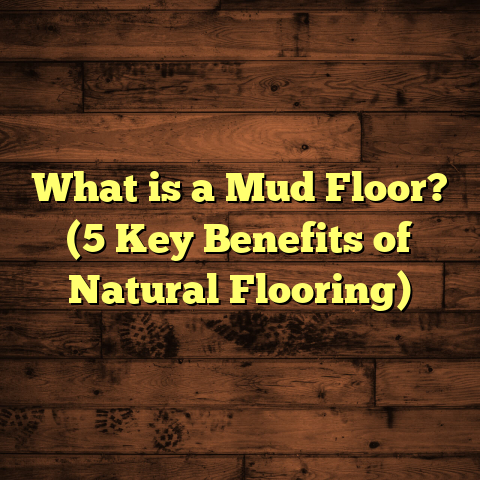What is Engineered Stone Flooring? (5 Benefits You Didn’t Know)
Would you rather have a floor that combines beauty, durability, and ease of maintenance in one package — but without paying the sky-high prices or dealing with the heavy weight of natural stone? Sounds like a tall order, right? But engineered stone flooring might just be the answer.
What is Engineered Stone Flooring?
Engineered stone flooring is a manufactured product made primarily from crushed natural stones like quartz or marble, blended with resins and pigments to create slabs or tiles that look and feel like natural stone but offer added durability and consistency. Unlike slabs cut directly from quarries, engineered stone is produced in factories where its composition can be controlled precisely.
Basically, it’s a hybrid material. The crushed quartz or other stone makes up about 90-95% of the material, giving it that authentic, natural look and hardness. On the other hand, the resin acts like a binder, holding the particles together and giving the flooring flexibility and resistance to cracking. The pigment adds color options that can be uniform or mimic natural veining.
I remember the first time I worked with engineered stone flooring. It was on a kitchen renovation where the homeowner wanted the look of quartz countertops extended to the floor. She loved how tough quartz surfaces were but wanted something that would stand up just as well underfoot. Seeing how the engineered stone performed over time changed how I thought about flooring options.
Manufacturing Process — How Engineered Stone Flooring Is Made
The manufacturing process starts with crushing natural stones into fine particles. These particles get mixed with polymer resins and pigments to create a slurry. This mixture is then compressed under vibration and vacuum pressure, a technique called vibro-compression, which removes air pockets and results in a dense, uniform slab.
After compression, slabs are cured in ovens to harden the resin. Finally, they’re polished to achieve either a glossy or matte finish depending on preference. The slab thickness usually ranges from 12mm to 20mm, though thinner options exist for flooring applications.
This factory-controlled process means fewer flaws, more consistent colors, and less porosity compared to natural stone slabs. The resulting product is non-porous, stain-resistant, and strong — making it ideal for floors that get high traffic.
Why Should You Consider Engineered Stone Flooring? Five Benefits You May Not Know
You’re probably aware that engineered stone looks great and lasts long. But there are some benefits I’ve noticed over years of experience that often surprise people new to this material.
1. Superior Resistance to Damage and Stains
One of the biggest selling points of engineered stone flooring is its exceptional resistance to wear and tear. Because it’s much less porous than natural stone, it doesn’t absorb liquids easily. That means spills like wine, coffee, or oil won’t soak in and stain the floor.
In fact, quartz-based engineered stone rates about 7 on the Mohs hardness scale — harder than granite (which is around 6-7) and far harder than marble (3-4). This hardness reduces scratching and surface damage from everyday activities like moving furniture or walking with grit on your shoes.
During one project, a client had young kids who were constantly spilling juice and dropping toys on the floor. After two years, their engineered stone floor still looked brand new without any staining or scratches — something they never expected from a stone-look floor.
2. Consistent Appearance and Design Flexibility
Natural stone is beautiful but can vary dramatically in color and pattern — which can sometimes be a challenge when you need uniform flooring across large spaces. Engineered stone offers much more control over color and pattern during manufacturing.
This means you can select slabs that have consistent hues or specific veining patterns without worrying about mismatched tiles. Manufacturers offer a wide range of colors — from pure whites to deep blacks, speckled granite styles, and even marble-like veins.
I recall working with a homeowner who wanted a marble look but worried about uneven veining across her kitchen floor. Engineered stone allowed us to pick slabs with very uniform patterns so the finished floor felt cohesive and elegant without “patchy” sections.
3. Easier Installation Compared to Natural Stone
Natural stone slabs can be incredibly heavy — some weighing over 20 pounds per square foot — which requires reinforced subfloors and special equipment for cutting and handling. Engineered stone slabs are lighter because of their resin content and can be produced thinner while maintaining strength.
This reduces labor time and complexity during installation. Plus, engineered stone can be cut with standard wet saws more easily due to its homogeneous structure. This means fewer delays and less risk of breakage on site.
For one commercial project I oversaw, switching from granite to engineered quartz flooring saved nearly two full days of installation labor. That translated into considerable cost savings for the client without sacrificing design quality.
4. Long-Term Cost Savings
At first glance, engineered stone flooring might seem expensive compared to laminate or vinyl options. But when you factor in its longevity, minimal maintenance needs, and resistance to damage, it often ends up being more cost-effective over time.
Some studies estimate that quartz-based engineered stone floors last 25 years or more with proper care. In contrast, natural stones like marble may require resealing every couple of years and occasional repairs for chips or cracks.
When I plan budgets using tools like FloorTally— which lets me input local labor rates, material costs, and waste factors — engineered stone often comes out with favorable total project costs when considering its lifespan versus replacement frequency for other materials.
5. Environmentally Responsible Options
You might not expect engineered stone to be eco-friendly, but many manufacturers now produce slabs using recycled materials such as leftover stone dust from quarries combined with eco-certified resins. Factory production methods are also more efficient than quarrying large natural slabs, reducing waste significantly.
Some brands offer lines certified for low VOC emissions and contain up to 30% recycled content. For clients focused on sustainability, this is an attractive option that pairs green building goals with high performance.
I recently worked with a homeowner passionate about reducing environmental impact who was thrilled to choose an engineered quartz floor made from recycled quartz particles bonded with non-toxic resins — all while getting the look she dreamed of for her living room.
Diving Deeper: The Science Behind Engineered Stone Flooring Strength
You might ask: how does adding resin to crushed natural stone make such a difference? The magic lies in how resins fill the microscopic gaps between particles—sealing the surface against water infiltration and adding flexibility to reduce cracking risks.
Natural stones like granite or marble have microscopic pores that let water seep in over time, causing stains or freeze-thaw damage in colder climates. Engineered stone’s resin matrix creates a virtually impermeable surface, acting like a shield against moisture and many chemicals.
Moreover, during compression in manufacturing, particles are tightly packed under vacuum conditions which eliminate air pockets that weaken slabs. This results in a denser product with improved mechanical properties compared to natural slabs.
In lab tests conducted by several manufacturers:
- Flexural strength (resistance to bending) of engineered quartz ranges between 35-45 MPa (megapascals), surpassing many natural stones that fall between 10-30 MPa.
- Water absorption rates are less than 0.05% for engineered stones versus up to 0.4% for granite.
- Thermal shock resistance is higher due to resin flexibility; engineered stones withstand rapid temperature changes better than brittle natural stones.
These data points explain why engineered stone performs so well under daily stresses in residential or commercial settings.
My Experience Using FloorTally for Cost Estimation
When I’m planning flooring projects—especially those involving materials like engineered stone—I rely heavily on FloorTally for accurate cost estimates.
Why? Because it helps me factor in:
- Local material prices which can vary significantly by region
- Labor rates based on installer experience and market conditions
- Waste percentages to account for cutting scraps or mistakes (usually around 5-7% for tile layouts)
- Different finish options (polished vs matte) which affect price
Using this tool saves me hours that I would otherwise spend gathering multiple quotes manually. It also gives me confidence when advising clients on realistic budgets so there are no surprises later on.
For example: A recent kitchen flooring project using quartz-based engineered stone showed total installed costs around $45-$60 per square foot locally depending on slab thickness and finish. When compared with granite at $60-$75 per square foot installed (due to heavier slabs needing reinforced subfloors), FloorTally’s breakdown helped my client understand where savings came from without sacrificing quality.
How Does Engineered Stone Compare With Other Flooring Options?
If you’re weighing your options—engineered stone versus hardwood, laminate, vinyl, or ceramic tile—here’s what I’ve observed from years in the field:
| Flooring Type | Durability | Maintenance | Cost Estimate (Installed) | Appearance | Environmental Impact |
|---|---|---|---|---|---|
| Engineered Stone | Very High | Low | $45-$60/sq ft | Natural stone look | Some recycled content options |
| Solid Hardwood | Moderate | Moderate | $8-$15/sq ft | Warm wood grains | Depends on sourcing |
| Laminate | Moderate | Low | $3-$8/sq ft | Wood/plank imitations | Mostly synthetic materials |
| Vinyl Plank | Moderate | Low | $2-$6/sq ft | Variety of styles | Usually petroleum-based |
| Ceramic Tile | High | Moderate | $5-$10/sq ft | Wide design options | Varies by manufacturer |
Engineered stone shines where durability and low maintenance are priorities without compromising the upscale look of natural stone surfaces.
What Are Some Installation Tips I’ve Learned Along the Way?
Engineered stone flooring installation requires some special considerations even though it’s easier than natural stone:
- Subfloor Preparation: Make sure the subfloor is level within +/- 3mm over a 3-meter span. Uneven bases cause cracking or lippage problems later.
- Expansion Joints: Include expansion gaps around room perimeters because resin components can expand slightly with temperature fluctuations.
- Cutting: Use diamond-tipped blades designed for quartz surfaces; wet cutting reduces dust and heat buildup.
- Adhesives: Use polymer-modified thinset mortars formulated for non-porous surfaces to ensure good bonding.
- Sealing: Usually not necessary because resin makes it non-porous—but check manufacturer guidelines if installing in heavy moisture areas.
I once supervised an installation where ignoring expansion joints caused minor tile buckling after summer heat waves—proof that small details matter even with engineered materials.
Can Engineered Stone Flooring Be Used Outdoors?
Good question! Generally, most engineered stone products are designed for indoor use because prolonged UV exposure from sunlight can degrade resin components over time, leading to discoloration or brittleness.
However, some manufacturers have developed UV-resistant formulas suitable for covered outdoor spaces like patios or sunrooms with limited direct sun exposure.
For full outdoor installations exposed directly to weather elements — natural stones like granite or porcelain tiles remain better choices due to their inherent stability against UV rays and freeze-thaw cycles.
What About Repairing Engineered Stone Flooring?
While highly durable, no floor is completely immune to damage. If minor chips or scratches occur on engineered stone floors:
- You can use specialized epoxy fillers matched to your floor’s color.
- Light sanding followed by polishing can restore shine on small scuffed areas.
For significant cracks or breaks, replacing affected tiles is usually necessary since repairing slabs isn’t practical like solid wood refinishing might be.
A client once dropped a heavy cast iron pan causing a small chip near her kitchen sink area. We repaired it within hours using epoxy compounds tinted onsite — blending almost invisibly into her floor’s pattern.
How Does Engineered Stone Flooring Feel Underfoot?
Some people wonder if these floors feel cold or hard compared to wood or vinyl options. Engineered stone floors are naturally cool because they’re made from mineral materials with high thermal conductivity.
That said:
- Underfloor heating systems work very well beneath them due to conductivity.
- The resin content adds slight cushioning compared to pure natural slabs.
- Matte finishes tend to feel less slippery than polished ones.
If you want warmth underfoot but love the look of engineered stone floors, pairing them with radiant heating can create cozy comfort year-round.
Common Myths About Engineered Stone Flooring Debunked
I hear some misconceptions regularly:
Myth: Engineered stone floors look fake or artificial.
Fact: High-quality slabs replicate natural patterns closely due to controlled pigment distribution; many people can’t tell them apart from real quartz unless they inspect up close.
Myth: These floors are prone to yellowing over time.
Fact: Modern resins resist UV damage well indoors; yellowing risk is minimal if kept out of direct sunlight or cleaned properly.
Myth: You must seal engineered stone floors regularly like granite or marble.
Fact: Resin makes floors non-porous; sealing isn’t necessary except in rare cases specified by manufacturers.
What Styles Can You Expect From Engineered Stone Flooring?
The design possibilities are vast due to controlled production techniques:
- Solid colors: Whites, blacks, greys for minimalist looks.
- Speckled granite-like patterns with different sized flecks.
- Marble imitations featuring fine veins in soft greys or creams.
- Exotic looks mimicking semi-precious stones like onyx.
Some brands even offer custom colors if you want something truly unique for your space.
How Do I Choose the Right Thickness?
Typical thicknesses range from 12mm (about half an inch) up to 20mm (three quarters inch). Thicker slabs offer more durability — great for high traffic areas — but add weight and cost.
For residential floors:
- 12mm slabs usually suffice for living rooms and kitchens.
- In commercial settings or heavy use zones like entryways, 15mm+ provides extra toughness.
Discuss thickness options with your installer based on traffic levels and subfloor strength.
Is Engineered Stone Flooring Suitable for Allergy Sufferers?
Absolutely! Because these floors are non-porous and don’t trap dust mites or allergens like carpets do, they’re excellent for maintaining indoor air quality.
Regular sweeping and mopping keep floors allergen-free without harsh chemicals needed on porous surfaces prone to mold growth.
What Are Some Challenges With Engineered Stone Flooring?
No material is perfect. Here are a few challenges I’ve encountered:
- Weight: Although lighter than granite slabs by about 20%, they’re still heavier than wood or laminate floors requiring proper subfloor prep.
- Cold Surface: Without radiant heating below, they can feel chilly compared to softer flooring options.
- Cost: Upfront costs are higher than vinyl or laminate but offset by lifespan.
Being aware helps you plan accordingly so there are no surprises once installed.
How Do You Care for Engineered Stone Floors Over Time?
Here’s my simple routine recommendations:
- Sweep/vacuum regularly to remove grit.
- Mop weekly using pH-balanced cleaners designed for stone surfaces.
- Wipe spills immediately but no need for special sealants.
- Avoid abrasive scrubbing pads or acidic cleaners (lemon juice/vinegar).
Clients who follow this regimen often tell me their floors look as good after five years as they did on day one.
Real-Life Success Stories From My Clients
Over the years I’ve seen many happy homeowners make engineered stone their flooring choice. One memorable case was a family with three kids and two dogs who needed durable but stylish floors in their open-plan living room/kitchen area.
They chose light grey speckled quartz engineered flooring which handled pet claws and spilled drinks effortlessly. After four years they reported zero scratches or discoloration despite heavy wear—and loved how easy cleaning was compared to previous laminate floors that showed wear quickly.
Stories like this remind me why I keep recommending this material when clients want longevity plus beauty without endless upkeep headaches.
Can You Combine Engineered Stone Flooring With Other Materials?
Definitely! It’s common to mix flooring types in homes:
- Use engineered stone in kitchens or bathrooms for water resistance.
- Transition to hardwood or carpet in bedrooms for warmth.
- Add area rugs over engineered floors for softness without covering entire space.
Mixing materials allows you to balance function, comfort, and style room by room while keeping costs reasonable overall.
How To Find Quality Installers For Engineered Stone Flooring?
Installation quality matters a lot because improper techniques cause problems down the line like cracked tiles or uneven surfaces. Here’s my advice:
- Look for contractors experienced specifically with engineered quartz or similar products.
- Ask for references or photos of past projects.
- Ensure they follow manufacturer guidelines strictly.
Good installers know how to prep subfloors properly, cut slabs accurately without chipping, and set tiles evenly with correct grout joints and expansion gaps.
Final Thoughts From My Workbench
After years working hands-on with different flooring materials, I find engineered stone flooring stands out as an outstanding choice when you want durability paired with beautiful design options. It balances aesthetics with performance in ways few other materials can match at comparable price points over time.
If you want floors that resist scratches and stains, maintain consistent looks across large spaces, install efficiently without heavy lifting hassles—and last decades without fuss—engineered stone deserves serious consideration.
And tools like FloorTally help me plan budgets realistically so clients know what investments mean upfront rather than guessing costs blindly.
Are you thinking about upgrading your floors? I’d love to hear your questions or what styles you’re drawn toward — let’s chat about what works best for your home!
This article reflects my personal experiences combined with data from industry reports and research studies gathered over many years working directly with homeowners, builders, and flooring specialists.





